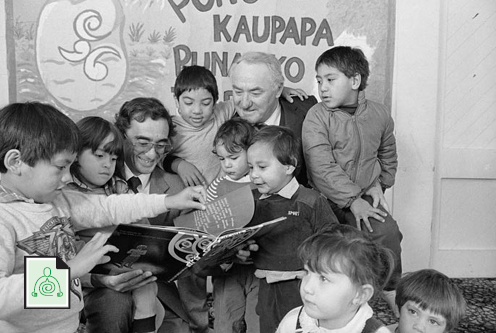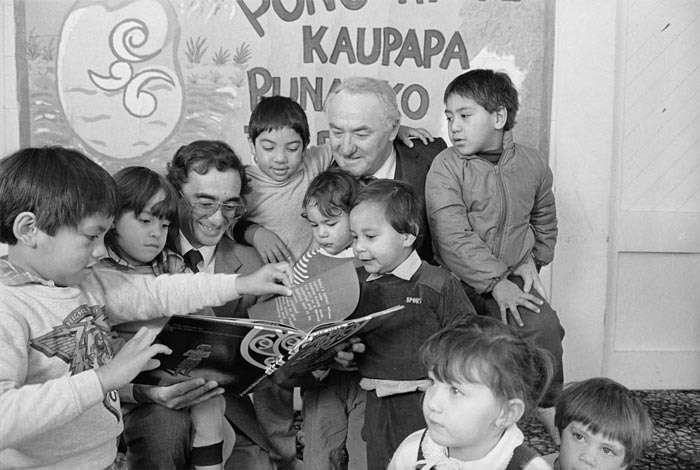Teacher support material: The WAI11 claim
Teacher support material
Chapter 7: 1975–1987 The WAI11 Claim
The seventh chapter of Te Mana o te Reo Māori introduces students to the Waitangi Tribunal. The Tribunal is an independent body that was established in 1975 to investigate alleged breaches of te Tiriti o Waitangi by the Crown.

In 1984, Ngā Kaiwhakapūmau i te Reo – an organisation committed to the revitalisation of te reo Māori – lodged a claim that impacted all Māori. It became known as ‘The Te Reo Māori Claim’. This chapter provides students with an overview of this claim and its significance for te reo Māori.
Te Mana o te Reo Māori – Chapter 7
On this page, you’ll find materials to support your students as they learn about the WAI11 claim, including key focus questions, suggested activities, and language support.
Contents
- Introducing this chapter
- Key themes
- Activities and learning experiences
- Language support
- Other resources
Introducing this chapter
Start with Te Tai Whakaea
Te Tai Whakaea website provides a wealth of information about the Tiriti o Waitangi settlement process. Exploring this digital content is a great way to introduce students to the information presented in Chapter 7 of the Te Mana o te Reo Māori digital story. The content on Te Tai Whakaea will help them understand the purpose of the Waitangi Tribunal and will point them in the direction of other sources of information to further develop their learning about this topic.
Chapter 7 poster image

Two of the panel members of the WAI11 claim, chairperson Eddie Durie (left) and Paul Temm QC, with students of the kōhanga reo at Waiwhetū in the Hutt Valley.
Alexander Turnbull Library, Dominion Post Collection (PAColl-7327); Reference: EP/1985/2942/15-F. Photograph by John Nicholson
The Chapter 7 poster from the poster pack He Pūkei Whakaahua o Te Mana o te Reo Māori shows two of the panel members for the WAI11 claim, Presiding Officer Eddie Durie (left) and Paul Temm QC, with students in the kōhanga reo at Waiwhetū, Lower Hutt. This image also features in Chapter 7 of the digital story. It provides some key questions and information to introduce your students to this chapter. You can use this poster to facilitate discussions with your students about the establishment of the Waitangi Tribunal. This can be a great way to help students identify what they already know about the Treaty settlements process and its impact on the history of te reo Māori.
Additional resource components
There is further content available for students to explore this topic:
- Te Mana o te Reo Māori timeline
- Te Mana o te Reo Māori biographies
- Public history talk: Te Mana o te Reo Māori
- Story: Te reo Māori – the Māori language (Te Ara)
Key themes
This resource tells the history of the decline and revitalisation of te reo Māori with a focus on five themes from Te Takanga o te Wā.
Te Takanga o te Wā Māori History Guidelines Year 1–8 (Te Kete Ipurangi)
Here are some key questions that relate to each of these themes. These questions are intentionally broad so that students can explore them in multiple ways.
-
Whakapapa
Tūpuna – Connections – Belonging – Identity – Culture – Community – Tikanga – Mana Whenua - Where do I fit in?
- Have my whānau or anyone I know ever been involved with a Treaty settlement claim through the Waitangi Tribunal?
-
Tūrangawaewae
Belonging – Identity – Culture – Community – Place – Continuity - Has it been settled yet?
- What was the outcome?
-
Mana Motuhake
Belonging – Identity – Mana – Controversy – Conflict – Consequences – Tino Rangatiratanga - What is the purpose of the Waitangi Tribunal?
- Who can make a claim to the Waitangi Tribunal?
- How does the Tribunal relate to the concept of Mana?
-
Kaitiakitanga
Time – Context – Perspective – Knowledge – Tikanga – Guardianship - Does the government have to follow the recommendations of the Waitangi Tribunal?
- What did the Waitangi Tribunal say about te reo Māori in the WAI11 report?
-
Whanaungatanga
Whānau – Hapū – Iwi – Whakapapa – Tūpuna – Connections – Community – Manaakitanga – Kotahitanga – Unity - Who lodged the Te Reo Māori Claim to the Waitangi Tribunal?
- Was it a particular iwi?
- On whose behalf was the claim lodged?
Each of these themes provides a way for learners to connect with the history of te reo Māori. Keep an eye out for these icons to see how activities and content in these resources link to each of these themes.
Activities and learning experiences
Here are some suggested activities for your students.
Activity 1: He whakataunga Tiriti – Treaty settlements
Themes:
Te Tai Whakaea website features a number of digital stories that share the Treaty settlement journeys of a number of different iwi. Choose one of these iwi stories to explore:
Use the following template to gather facts about your chosen iwi Treaty settlement story and the WAI11 claim:
He whakataunga Tiriti worksheet (PDF)
Once you’ve gathered your information, organise it into a report or presentation for your class to demonstrate your learning. You could present your findings as a:
- written report
- visual poster
- digital story
- storyboard
- skit.
Activity 2: He tukunga whakataunga Tiriti – A Treaty settlement process
Theme:
Chapter 7 provides information about the Treaty settlement process. Processes can be difficult to explain sometimes. Showing information in a visual way can help communicate that information to another person. One way to do this is by creating a flow diagram.
A flow diagram is a visual chart that shows the steps of any process from beginning to end, using process boxes, flow lines or arrows, and other symbols.
Use the information in Chapter 7 and other appropriate sources to create a flow diagram showing the Treaty settlement process. Use arrows, text boxes, symbols or images to explain the process in a visual format. The information should be presented so it is clear and can be understood by somebody who does not know anything about the Treaty settlement process.
Once you have created your flow diagram, test it on a friend or a family member – does your diagram help them understand the Treaty settlement process?
Activity 3: Te whakarauora i te reo Māori – Maori language revitalisation
Themes:
The WAI11 claim was an action taken by a group called Ngā Kaiwhakapūmau i te reo Māori against the Crown for the decline of Māori language. There have been many other groups and individuals who have taken action to:
- promote te reo Māori
- protest against the government’s failure to protect te reo Māori
- revitalise te reo Māori.
Choose one such group, individual or event to research. Find out what this group’s / individual’s / event’s contribution has been to the revitalisation of te reo Māori. You may choose to research someone in your own whānau. You may choose to focus on one of the biographies featured on Te Mana o te Reo Māori website.
Te Mana o te Reo Māori biographies
Report your findings in a format that will appeal to your intended audience (e.g. your whānau, classmates, etc.). You might decide to create:
- a Google Slides presentation
- a photo album
- an oral presentation.
In your presentation, you should describe the person, group or event that you have selected, explain why you selected them/it, what action was taken, and whether or not it was successful or achieved its intended goals.
Language support
tukanga
process
whakataunga
settlement
whakarauora
revitalisation
Other resources
- Keeping promises: The Treaty settlement process (Te Kete Ipurangi)
- Publications and resources (Waitangi Tribunal)
- Te Wiki o Te Reo Māori – Māori Language Week (NZHistory)
Downloads for this chapter
- Teacher support material for Chapter 7 (PDF, 1.2MB)
- Student workbook – Tōku Ara Reo Māori: My Māori Language Journey (PDF, 0.8MB)
- Poster pack – He Pūkei Whakaahua o Te Mana o te Reo Māori (PDF, 9.5MB)